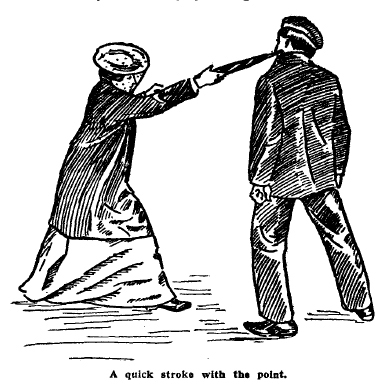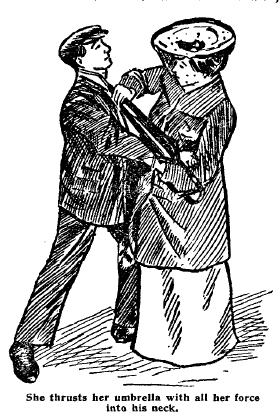- Originally published on the Bartitsu.org site on Friday, 30th July 2010
Update: since the following article was written, the Bartitsu Society has come across this 1901 interview with E.W. Barton-Wright that offers some more information on his conception of “Bartitsu kickboxing”.
E.W. Barton-Wright evidently felt that while both boxing and kicking had their places within Bartitsu, they required substantial modification for use in actual self defence. Unfortunately, he never detailed the nature of his modifications, which leaves this aspect of the Bartitsu curriculum open to speculation based on a set of cryptic hints. This article examines his comments on boxing and kicking and offers some educated guesses about their place in the repertoire.
Barton-Wright was fulsome in his praise of boxing, which was virtually synonymous with the idea of “self defence” in London at the turn of the 20th century. In introducing his radical cross-training concept of Bartitsu, however, he was also careful to point out that even “manly and efficacious” British fisticuffs might not be enough to cope with a determined street attacker who didn’t play by the rules:
If one gets into a row and plays the game in the recognised style of English fair play – with fists – the opponent will very likely rush in and close, in order to avoid a blow. Then comes the moment for wrestling in the secret Japanese way. Instantly the unwary one is caught and thrown so violently that he is placed hors de combat, without even sufficient strength left to retire unassisted from the field. – Barton-Wright, “Black and White Budget” magazine, December 1900
Taken at face value, this comment suggests that the forewarned but unarmed Bartitsu-trained defender would adopt a boxing guard and spar specifically in order to “sucker” their adversary into close quarters. At that point the defender would deploy jiujitsu as a sort of secret weapon. In fact, both of Barton-Wright’s “boxing” scenarios in that article proposed that an unarmed fight might begin with fisticuffs, but would end with jiujitsu:
Again, should it happen that the assailant is a better boxer than oneself, the knowledge of Japanese wrestling will enable one to close and throw him without any risk of getting hurt oneself. – Ibid.
He was less enthusiastic about French kickboxing. While acknowledging that kicking and countering kicks were important aspects of self defence training, he asserted that:
Another branch of Bartitsu is that in which the feet and hands are both employed, which is an adaptation of boxing and Savate. The guards are done in a slightly different style from boxing, being much more numerous as well. The use of the feet is also done quite differently from the French Savate. This latter … is quite useless as a means of self-defence when done in the way Frenchmen employ it. – Ibid.
Another cryptic comment on the subject of kicking in self defence:
Mr. Barton-Wright does not profess to teach his pupils how to kick each other, but merely to know how to be able to return kicks with interest should one be attacked in this manner. – Ibid.
Later, an article in the Pall Mall Gazette also mentioned that the kicking methods adopted at the Bartitsu Club were “somewhat different from the accepted French method.”
In considering Barton-Wright’s comments on savate, it’s worth recalling the traditional Anglo-French rivalry and the middle-class London cultural bias against kicking in self defence as being “un-English”. Also, at a time of very intense nationalism, B-W’s idea that it was socially “permissible” for English gentlemen to learn these foreign skills was still relatively novel and far from being universally accepted. Perhaps B-W deliberately de-emphasised the kicking content of Bartitsu and distanced it from the French method in his articles and lectures as a gesture towards social respectability. Likewise, he may have been attempting to score points by suggesting that the Bartitsu Club was promoting a “new, improved” (even an Anglicised) version of savate.
Both Barton-Wright himself and Bartitsu Club instructor Pierre Vigny were primarily interested in teaching pragmatic self-defence, so it’s likely that neither of them had much time for the balletic, light-contact, high kicking style that was then becoming popular as a bourgeois exercise in Paris. If we take B-W’s comments on kicking literally, then presumably he was simply advocating generic street fighting kicks of no particular national origin.
Several months later, in a lecture for the Japan Society of London, he noted that:
Under Bartitsu is included boxing, or the use of the fist as a hitting medium, the use of the feet both in an offensive and defensive sense, the use of the walking stick as a means of self-defence. Judo and jujitsu, which (are) secret styles of Japanese wrestling, (I) would call close play as applied to self-defence.
In order to ensure as far as it was possible immunity against injury in cowardly attacks or quarrels, (one) must understand boxing in order to thoroughly appreciate the danger and rapidity of a well-directed blow, and the particular parts of the body which were scientifically attacked. The same, of course, applied to the use of the foot or the stick … judo and jiujitsu are not designed as primary means of attack and defence against a boxer or a man who kicks you, but (are) only supposed to be used after coming to close quarters, and in order to get to close quarters, it is absolutely necessary to understand boxing and the use of the foot. – Barton-Wright, “Jiu jitsu and Judo: the Japanese Art of Self Defence from a British Athletic Point of View”, February 1901
And then:
Directly one (sees) a man, one ought to know whether he (is) a man to go for at once, or whether he should be allowed to have first turn and afterwards come in one’s self. – Ibid
This reads as if Barton-Wright was moving towards a more specifically integrated unarmed combat system, perhaps combining the defensive aspects of boxing and savate (guards, slips, parries etc.) with a limited range of punches and kicks. These would be transitional, counter-offensive actions between the preferred ranges of stick fighting and jiujitsu. Thus, again, the unarmed/disarmed Bartitsu practitioner might assume a boxing guard stance and defend/counter according to orthodox Anglo-French styles, but then segue into jiujitsu to actually bring the fight to a close.
Barton-Wright’s articles on “Self Defence with a Walking Stick” include several defence sequences that feature boxing punches and savate kicks, but in each case, the context is the Bartitsu-trained defender countering punching or kicking attacks with his trusty cane. The Black and White Budget article also featured a photograph of Vigny executing what looks like a waist-high front thrust or crescent kick. The implication is that students at the Bartitsu Club might have practiced the basic offensive techniques of boxing and savate partially in order to simulate the types of attacks they might face in the streets; to “role-play” as boxers and savateurs for training purposes.
Barton-Wright’s reference to “more numerous guards”, performed in a “slightly different style” to orthodox boxing, may be significant. It seems highly likely that he and Vigny would have discounted those techniques that relied upon either fighter wearing boxing gloves. If so, they may have been inspired by the older, pre-Queensberry Rules versions of pugilism and savate, which were designed for bare-knuckle fighting and did include a diverse range of guards. Also, Bartitsu defences against unarmed striking attacks were not restricted by the rules of boxing; the counter-attack might be a kick, a punch, a jiujitsu atemi strike, a throw and/or a submission technique.
While the most dangerous stick and jiujitsu techniques could not be fully applied in safe training, via recreational (kick)boxing the Bartitsu practitioner could still attain the sense of timing, distance, contact and unpredictability that can only be honed by unrehearsed sparring.
Due to the speculative nature of canonical Bartitsu (kick)boxing, Bartitsu revivalists tend to take an eclectic approach to their kicking and punching curricula, drawing from various late 19th and early 20th century sources.












